Thomas James Richards, Diaries, Transcript Vol. 1, 26 August 1914 to 24 April 1915 - Part 16
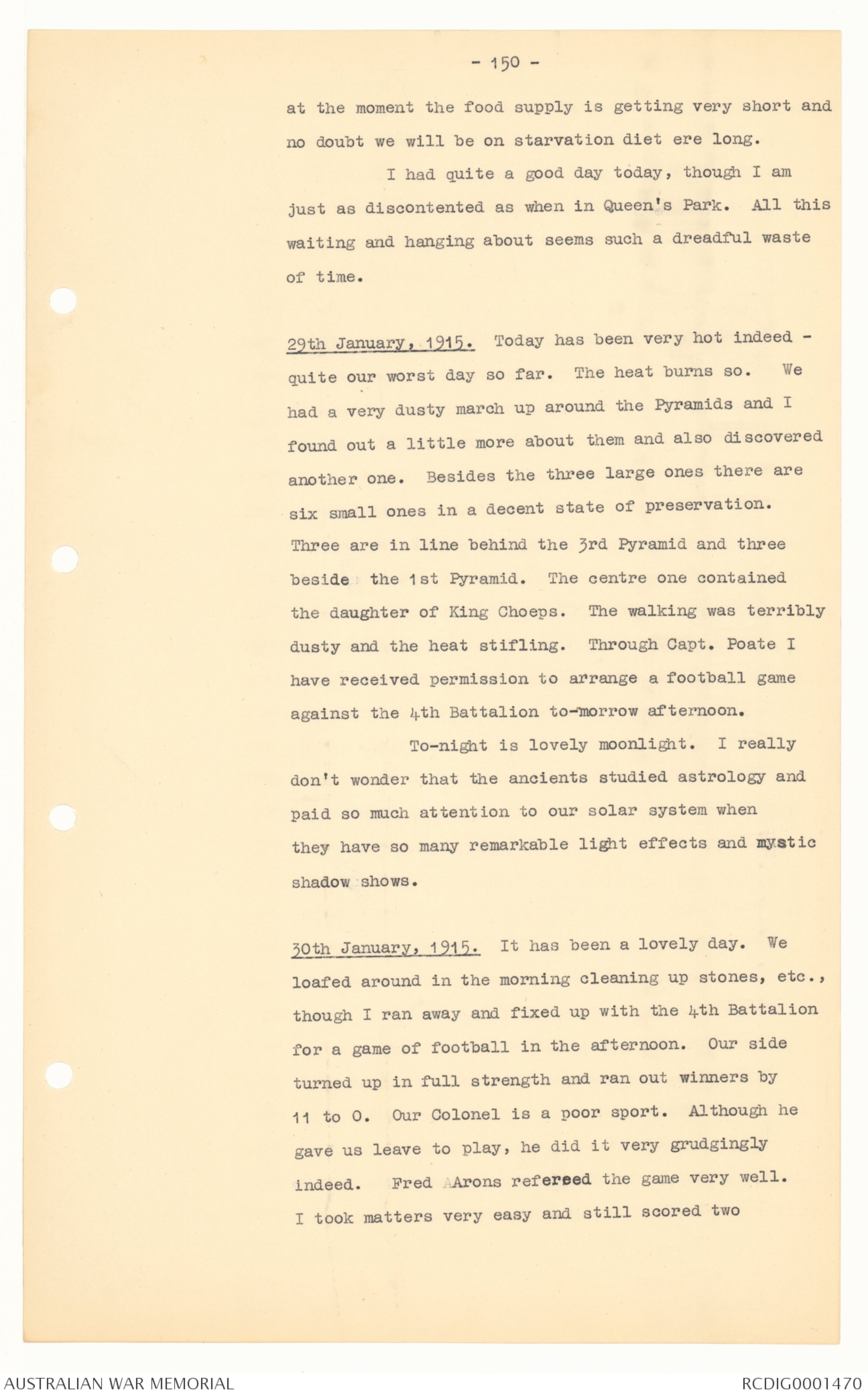

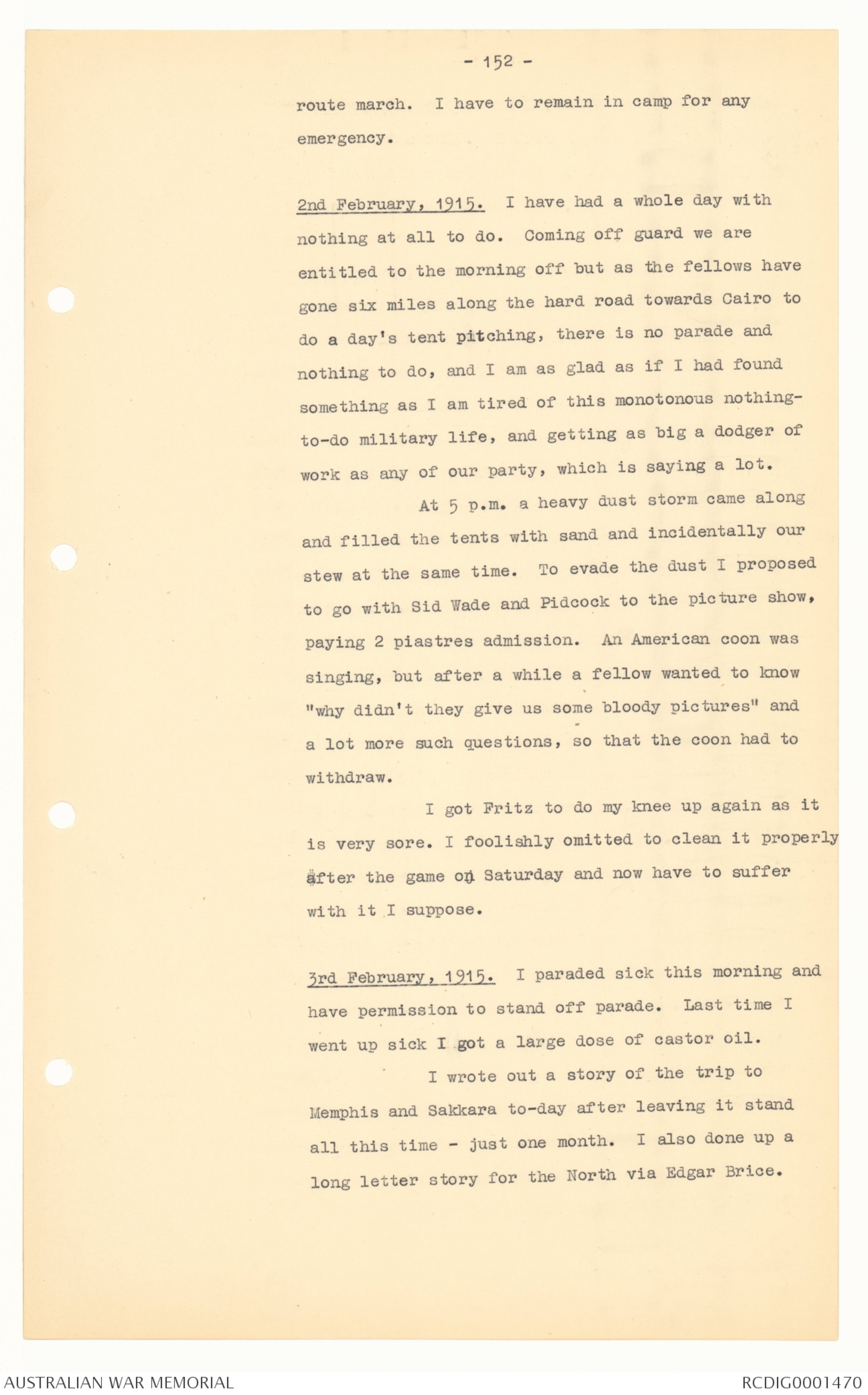
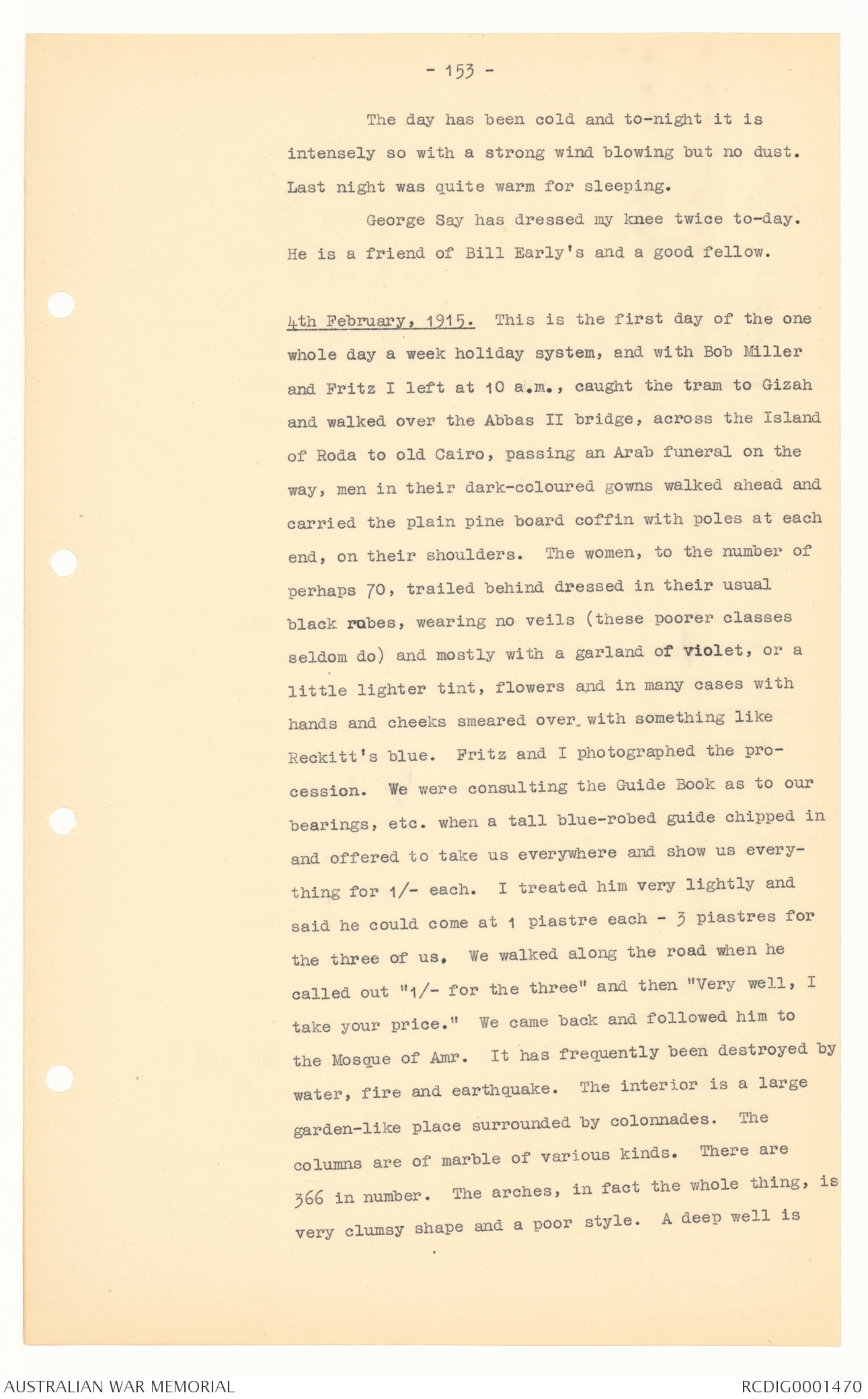
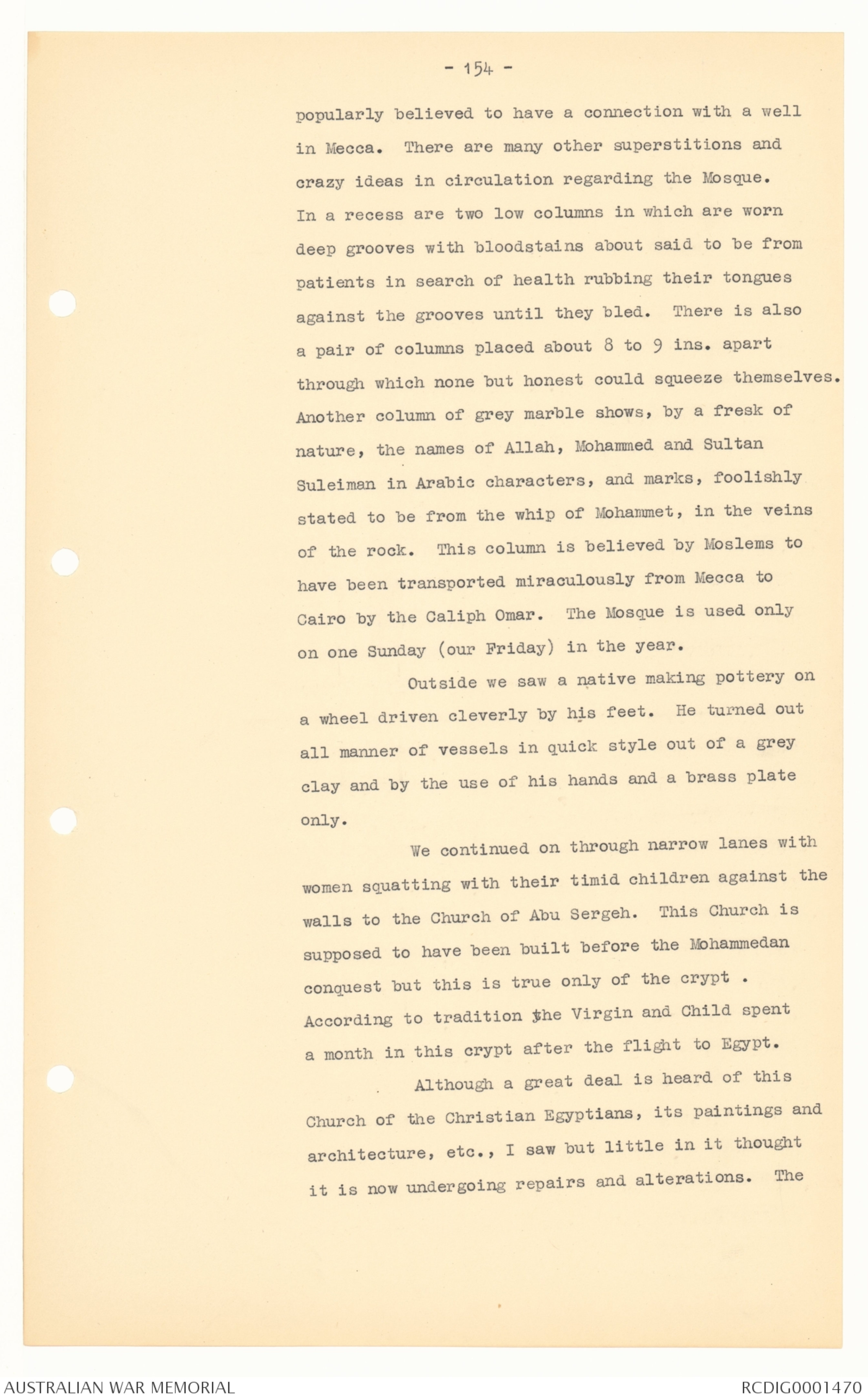
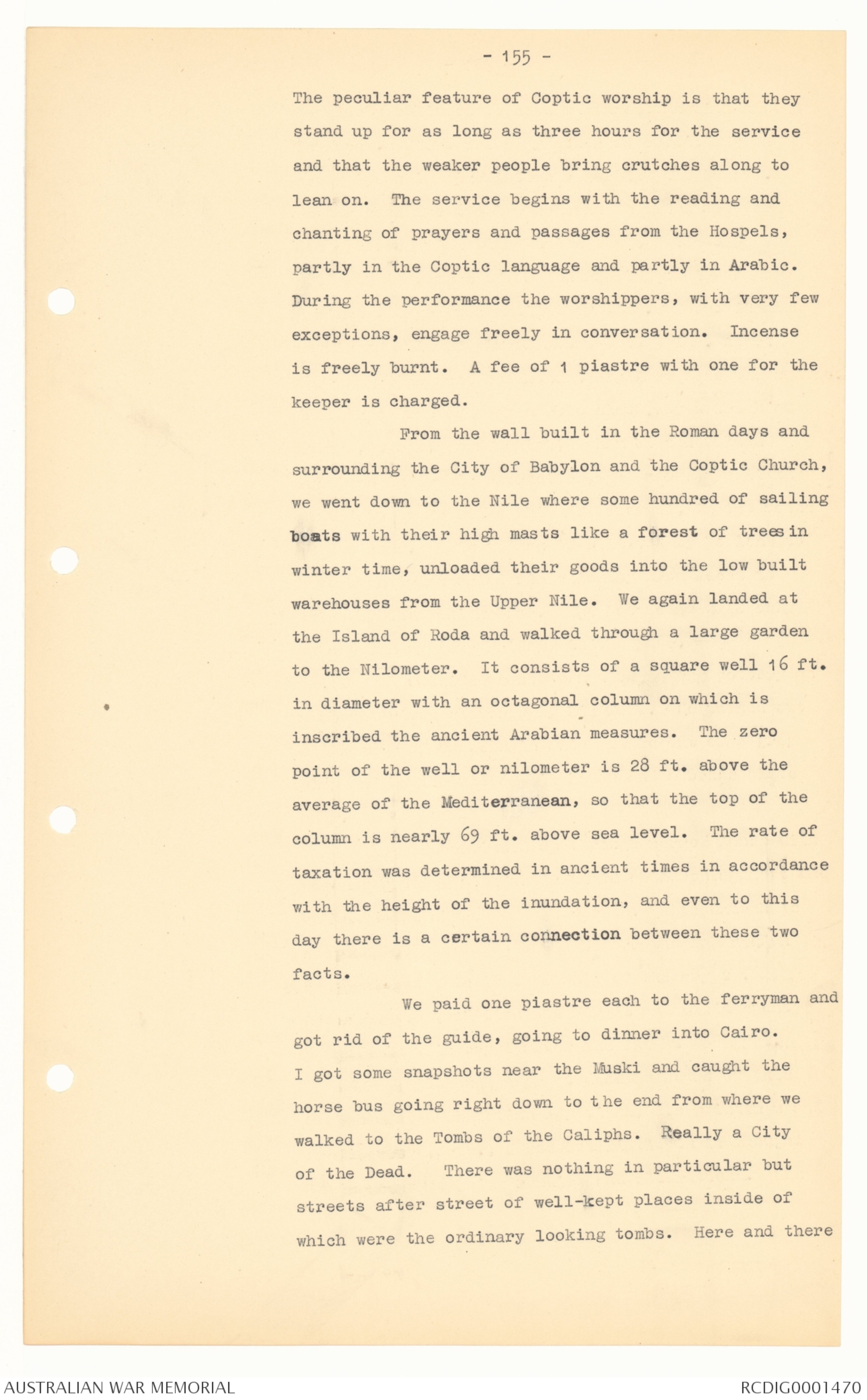
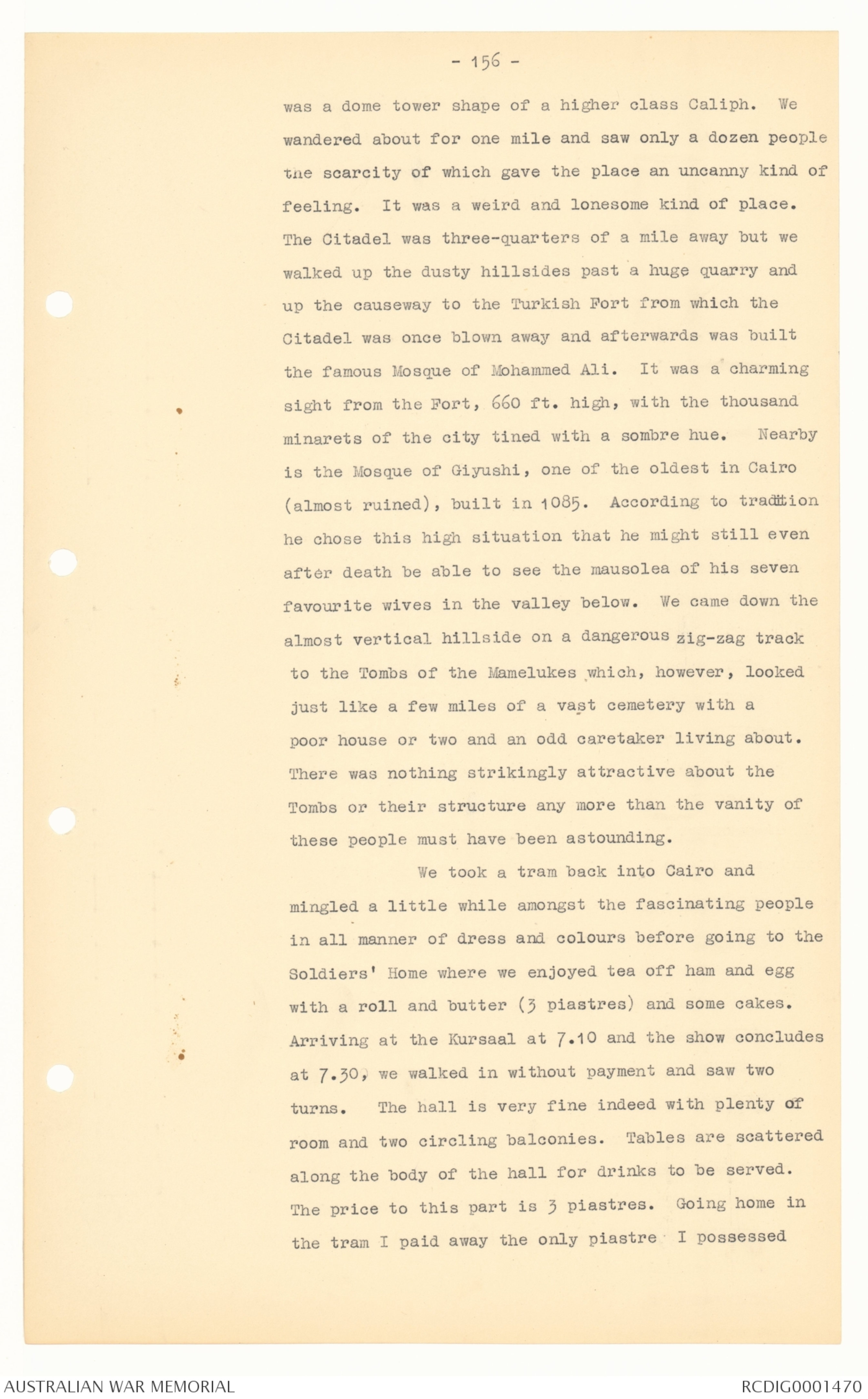


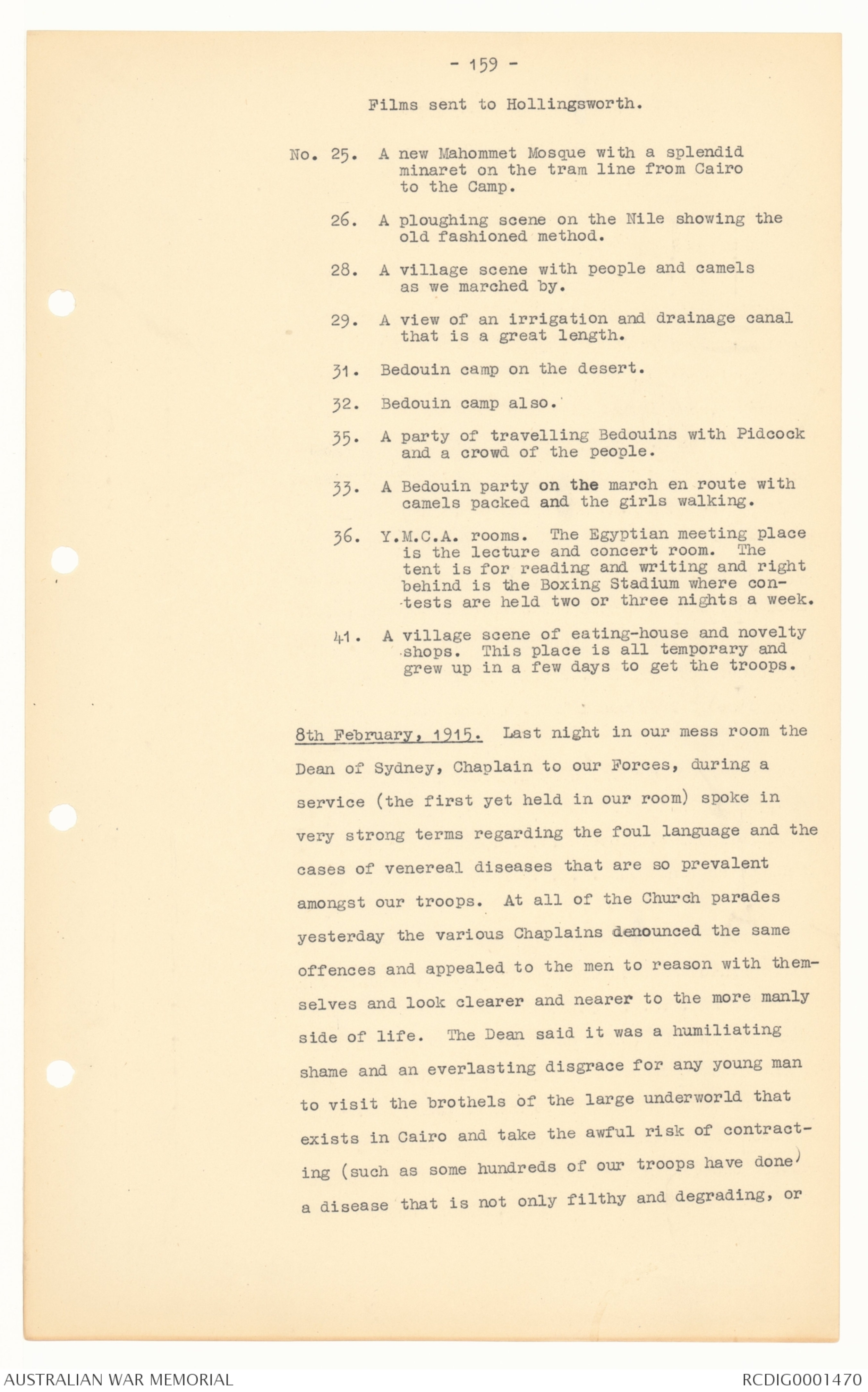
- 150 -
at the moment the food supply is getting very short and
no doubt we will be on starvation diet ere long.
I had quite a good day today, though I am
just as discontented as when in Queen's Park. All this
waiting and hanging about seems such a dreadful waste
of time.
29th January, 1915. Today has been very hot indeed -
quite our worst day so far. The heat burns so. We
had a very dusty march up around the Pyramids and I
found out a little more about them and also discovered
another one. Besides the three large ones there are
six small ones in a decent state of preservation.
Three are in line behind the 3rd Pyramid and three
beside the 1st Pyramid. The centre one contained
the daughter of King Choeps. The walking was terribly
dusty and the heat stifling. Through Capt. Poate I
have received permission to arrange a football game
against the 4th Battalion to-morrow afternoon.
To-night is lovely moonlight. I really
don't wonder that the ancients studied astrology and
paid so much attention to our solar system when
they have so many remarkable light effects and mystic
shadow shows.
30th January, 1915. It has been a lovely day. We
loafed around in the morning cleaning up stones, etc.,
though I ran away and fixed up with the 4th Battalion
for a game of football in the afternoon. Our side
turned up in full strength and ran out winners by
11 to 0. Our Colonel is a poor sport. Although he
gave us leave to play, he did it very grudgingly
indeed. Fred AArons refereed the game very well.
I took matters very easy and still scored two
- 151 -
30th January, 1915. We have had an easy day to-day.
Church parade only. I drew a pass but did not go out.
I printed off a lot of decent photos for myself and
got away some correspondence.
1st February, 1915. It is Tuesday morning now but I
am writing up yesterday from to-day's viewpoint.
Yesterday I was on guard and luckily enough
I drew the last relief - 6 to 10 evening and the
following morning. This was grand, as it gave me the
whole day in which to sleep and lie about and I've
never had such an idle day for years; going on duty
just as the evening lights and shadows became so
strikingly interestingly, and later the township lights,
or camp lights, gleam through the darkness with
several brass bands of the different Battalions
hammering out their music. I was doing duty on the
back line right upon the hill where the top half of
the 1st and 2nd Pyramids kept me company. At 9.30
'lights out' blew and the lights dwindled away one at
a time until in a few minutes the whole valley had
undergone a regular transformation. I slept soundly
in the guard tent from 10.15 to 5.45 a.m. when, in
the darkness, I relieved the fellow on the top line
again. Shortly afterwards the morning lights appeared
over the Pyramid and fought with the thick clouds for
supremacy and leaving the pretty effects of the
struggle for my contemplation and admiration. The
first bugle call was at 6.15 and from now until 6.30
there were a dozen or more reveilles blown and three
brass bands banging out a thundering noise to get the
fellows awake and out of bed. It is very impressive,
this awakening of the camp.
Nearly all of the men have gone on a long
- 152 -
route march. I have to remain in camp for any
emergency.
2nd February, 1915. I have had a whole day with
nothing at all to do. Coming off guard we are
entitled to the morning off but as the fellows have
gone six miles along the hard road towards Cairo to
do a day's tent pitching, there is no parade and
nothing to do, and I am as glad as if I had found
something as I am tired of this monotonous nothing-
to-do military life, and getting as big a dodger of
work as any of our party, which is saying a lot.
At 5 p.m. a heavy dust storm came along
and filled the tents with sand and incidentally our
stew at the same time. To evade the dust I proposed
to go with Sid Wade and Pidcock to the picture show,
paying 2 piastres admission. An American coon was
singing, but after a while a fellow wanted to know
"why didn't they give us some bloody pictures" and
a lot more such questions, so that the coon had to
withdraw.
I got Fritz to do my knee up again as it
is very sore. I foolishly omitted to clean it properly
after the game on Saturday and now have to suffer
with it I suppose.
3rd February, 1915. I paraded sick this morning and
have permission to stand off parade. Last time I
went up sick I got a large dose of castor oil.
I wrote out a story of the trip to
Memphis and Sakkara to-day after leaving it stand
all this time - just one month. I also done up a
long letter story for the North via Edgar Brice.
- 153 -
The day has been cold and to-night it is
intensely so with a strong wind blowing but no dust.
Last night was quite warm for sleeping.
George Say has dressed my knee twice to-day.
He is a friend of Bill Early's and a good fellow.
4th February, 1915. This is the first day of the one
whole day a week holiday system, and with Bob Miller
and Fritz I left at 10 a.m., caught the tram to Gizah
and walked over the Abbas II bridge, across the Island
of Roda to old Cairo, passing an Arab funeral on the
way, men in their dark-coloured gowns walked ahead and
carried the plain pine board coffin with poles at each
end, on their shoulders. The women, to the number of
perhaps 70, trailed behind dressed in their usual
black rubes, wearing no veils (these poorer classes
seldom do) and mostly with a garland of violet, or a
little lighter tint, flowers and in many cases with
hands and cheeks smeared over, with something like
Reckitt's blue. Fritz and I photographed the procession.
We were consulting the Guide Book as to our
bearings, etc. when a tall blue-robed guide chipped in
and offered to take us everywhere and show us everything
for 1/- each. I treated him very lightly and
said he could come at 1 piastre each - 3 piastres for
the three of us. We walked along the road when he
called out "1/- for the three" and then "Very well, I
take your price." We came back and followed him to
the Mosque of Amr. It has frequently been destroyed by
water, fire and earthquake. The interior is a large
garden-like place surrounded by colonnades. The
columns are of marble of various kinds. There are
366 in number. The arches, in fact the whole thing, is
very clumsy shape and a poor style. A deep well is
- 154 -
popularly believed to have a connection with a well
in Mecca. There are many other superstitions and
crazy ideas in circulation regarding the Mosque.
In a recess are two low columns in which are worn
deep grooves with bloodstains about said to be from
patients in search of health rubbing their tongues
against the grooves until they bled. There is also
a pair of columns placed about 8 to 9 ins. apart
through which none but honest could squeeze themselves.
Another column of grey marble shows, by a freak of
nature, the names of Allah, Mohammed and Sultan
Suleiman in Arabic characters, and marks, foolishly
stated to be from the whip of Mohammet, in the veins
of the rock. This column is believed by Moslems to
have been transported miraculously from Mecca to
Cairo by the Caliph Omar. The Mosque is used only
on one Sunday (our Friday) in the year.
Outside we saw a native making pottery on
a wheel driven cleverly by his feet. He turned out
all manner of vessels in quick style out of a grey
clay and by the use of his hands and a brass plate
only.
We continued on through narrow lanes with
women squatting with their timid children against the
walls to the Church of Abu Sergeh. This Church is
supposed to have been built before the Mohammedan
conquest but this is true only of the crypt.
According to tradition the Virgin and Child spent
a month in this crypt after the flight to Egypt.
Although a great deal is heard of this
Church of the Christian Egyptians, its paintings and
architecture, etc., I saw but little in it thought
it is now undergoing repairs and alterations. The
- 155 -
The peculiar feature of Coptic worship is that they
stand up for as long as three hours for the service
and that the weaker people bring crutches along to
lean on. The service begins with the reading and
chanting of prayers and passages from the Hospels,
partly in the Coptic language and partly in Arabic.
During the performance the worshippers, with very few
exceptions, engage freely in conversation. Incense
is freely burnt. A fee of 1 piastre with one for the
keeper is charged.
From the wall built in the Roman days and
surrounding the City of Babylon and the Coptic Church,
we went down to the Nile where some hundred of sailing
boats with their high masts like a forest of trees in
winter time, unloaded their goods into the low built
warehouses from the Upper Nile. We again landed at
the Island of Roda and walked through a large garden
to the Nilometer. It consists of a square well 16 ft.
in diameter with an octagonal column on which is
inscribed the ancient Arabian measures. The zero
point of the well or nilometer is 28 ft. above the
average of the Mediterranean, so that the top of the
column is nearly 69 ft. above sea level. The rate of
taxation was determined in ancient times in accordance
with the height of the inundation, and even to this
day there is a certain connection between these two
facts.
We paid one piastre each to the ferryman and
got rid of the guide, going to dinner into Cairo.
I got some snapshots near the Muski and caught the
horse bus going right down to the end from where we
walked to the Tombs of the Caliphs. Really a City
of the Dead. There was nothing in particular but
streets after street of well-kept places inside of
which were the ordinary looking tombs. Here and there
- 156 -
was a dome tower shape of a higher class Caliph. We
wandered about for one mile and saw only a dozen people
the scarcity of which gave the place an uncanny kind of
feeling. It was a weird and lonesome kind of place.
The Citadel was three-quarters of a mile away but we
walked up the dusty hillsides past a huge quarry and
up the causeway to the Turkish Fort from which the
Citadel was once blown away and afterwards was built
the famous Mosque of Mohammed Ali. It was a charming
sight from the Fort, 660 ft. high, with the thousand
minarets of the city tined with a sombre hue. Nearby
is the Mosque of Giyushi, one of the oldest in Cairo
(almost ruined), built in 1085. According to tradition
he chose this high situation that he might still even
after death be able to see the mausolea of his seven
favourite wives in the valley below. We came down the
almost vertical hillside on a dangerous zig-zag track
to the Tombs of the Mamelukes which, however, looked
just like a few miles of a vast cemetery with a
poor house or two and an odd caretaker living about.
There was nothing strikingly attractive about the
Tombs or their structure any more than the vanity of
these people must have been astounding.
We took a tram back into Cairo and
mingled a little while amongst the fascinating people
in all manner of dress and colours before going to the
Soldiers' Home where we enjoyed tea off ham and egg
with a roll and butter (3 piastres) and some cakes.
Arriving at the Kursaal at 7.10 and the show concludes
at 7.30, we walked in without payment and saw two
turns. The hall is very fine indeed with plenty of
room and two circling balconies. Tables are scattered
along the body of the hall for drinks to be served.
The price to this part is 3 piastres. Going home in
the tram I paid away the only piastre I possessed
- 157 -
so that I landed back into camp without a cent. It
is the first time ever I remember being actually broke.
A fellow owes me 8 piastres and I owe 9 piastres so
you see I am really in debt and pay day is not until
five more days yet.
5th February, 1915. It is two months to-day since we
arrived in Egypt and I have only written to England
once.
I should have gone on sick parade to-day
instead of tent pitching in full marching order down
on the footer grounds at Mena.
I called on Ted Larkin to-night. He is a
peculiar type of person to be a Member of Parliament.
His tales circled round can-can and the lewdness of
Cairo in a light jocular manner. He played football
the other day and boomed the miserable game in the
Cairo press. I can't see how the Australian Government
is going to be strengthened or even run on honest
lines when this type of man can secure recognition
and a seat in the House.
6th February, 1915. I went on early morning parade
but as I limped badly the Warrant Officer sent me off
so I stayed away all day long, printing and developing
mostly for H. Miller. I, however, found a good way
to fix prints and obtain a dark kind of black and
white effect in using self-toning paper - first
leaving salt and water for 10 minutes before fixing
in hypo. as usual.
I have at last got a 15 page description of
our trip to Memphis for Hollingsworth, also a 4 page
one for Edgar Brice and I hope to get something similar
for Harold Austin and the Manly Daily.
- 158 -
The reinforcements have arrived in Cairo and
are located on the other side of the desert from us -
perhaps 14 miles away. Boxing is in full swing at
the Victorian Stadium twice a week. In several of the
Battalion mess rooms at night tournaments are fought
off, midst much excitement. There is a good deal of
all kinds of football being played but the fellows
are not raving about it on account of having so much
marching to do on this trying sand. Several of the
Victorian Battalions have gone to the Suez. Some of
the New Zealanders are already there. Reports of
yesterday show that considerable fighting has taken
place and some 3,000 Turks killed. Rumours of all
kinds are in circulation and our fellows are anxiously
awaiting orders to get down and on to it, as we have
little money and to do Cairo requires more than from
1/- to 2/- a day. The authorities will not pay more
than 2/- a day to any private. I have to stop buying
my daily paper nowadays. I'll see that I don't get so
short of funds again.
I have listened with interest to a lecture
on the war and particularly dealing with Belgium, by
a Schotchman and a Y.M.C.A. director. The lecture was
given in the Victorian Y.M.C.A. shed and was crowded
out.
7th February, 1915. Church parade this morning and
then to a lecture at the Sydney Y.M.C.A. on the
"Romance of the Desert." He tried, in fact did prove
that life of a strange type existed everywhere on the
desert. Anyhow it changed my feeling that there is
no charm in the desert to one of there being much
romance in the desert. There is considerable difference
between the two.
- 159 -
Films sent to Hollingsworth.
No. 25. A new Mahommet Mosque with a splendid
minaret on the tram line from Cairo
to the Camp.
26. A ploughing scene on the Nile showing the
old fashioned method.
28. A village scene with people and camels
as we marched by.
29. A view of an irrigation and drainage canal
that is a great length.
31. Bedouin camp on the desert.
32. Bedouin camp also.
35. A party of travelling Bedouins with Pidcock
and a crowd of the people.
33. A Bedouin party on the march en route with
camels packed and the girls walking.
36. Y.M.C.A. rooms. The Egyptian meeting place
is the lecture and concert room. The
tent is for reading and writing and right
behind is the Boxing Stadium where contests
are held two or three nights a week.
41. A village scene of eating-house and novelty
shops. This place is all temporary and
grew up in a few days to get the troops.
8th February, 1915. Last night in our mess room the
Dean of Sydney, Chaplain to our Forces, during a
service (the first yet held in our room) spoke in
very strong terms regarding the foul language and the
cases of venereal diseases that are so prevalent
amongst our troops. At all of the Church parades
yesterday the various Chaplains denounced the same
offences and appealed to the men to reason with themselves
and look clearer and nearer to the more manly
side of life. The Dean said it was a humiliating
shame and an everlasting disgrace for any young man
to visit the brothels of the large underworld that
exists in Cairo and take the awful risk of contracting
(such as some hundreds of our troops have done)
a disease that is not only filthy and degrading, or
 Marisa Bortolotto
Marisa BortolottoThis transcription item is now locked to you for editing. To release the lock either Save your changes or Cancel.
This lock will be automatically released after 60 minutes of inactivity.